Landscape Value in the Spanish Costa del Sol’s Real Estate Market: The Case of Marbella
Abstract
1. Introduction
2. Literature Review
3. Materials and Methods
3.1. Study Area
3.2. Variables
3.2.1. Housing Sales Price (PRICE, UPRICE)
3.2.2. Commercial Area (AREA)
3.2.3. Landscape View of the House (VIEW)
3.2.4. Qualitative Segment of the Real Estate Market (TYPE)
3.2.5. Euclidean Distance to the Sea (DIST)
3.3. Dataset Preparation
- A viewpoints layer was created for each house sampled in the study area. To do this, the polygons layer representing the plots of different urban buildings was transformed into a points layer by calculating the centroid of each polygon (in this case, the layer had 403 observation points). To this points layer, an attribute referring to the observer’s standard height (1.65 m) and visibility radius (five kilometres) was applied.
- After configuring the observation points, the visual basins were calculated with the viewshed algorithm based on the DSM, assuming the default values provided by the tool in terms of Earth sphericity and the atmospheric refractive index. This calculation process was performed 403 times, once for each observation point, obtaining a raster layer with binary values: 0 (not visible) and 1 (visible areas).
- Finally, the visible area value in square meters was calculated for each of the 403 visual basins. The visible surface was the result of multiplying the number of pixels with value 1 by the surface of each pixel (25 square meters in this case study).
- The perceived surface characteristics were classified by cross-referencing the information of the landscape units that cover the entire study area.
3.4. Model Specification: Penalized Spline Additive Models and Geostatistical Extension
4. Results
4.1. Results of View Estimation Calculations
4.2. Results of the Geoadditive Model
4.3. Discussion of the Results
5. Conclusions
Author Contributions
Funding
Data Availability Statement
Conflicts of Interest
References
- United Nations. Available online: http://www.un.org (accessed on 1 February 2023).
- Del Giudice, V.; De Paola, P.; Morano, P.; Tajani, F.; Del Giudice, F.P.; Anelli, D. Depreciation of Residential Buildings and Maintenance Strategies in Urban Multicultural Contexts. In Values, Cities and Migrations; Napoli, G., Mondini, G., Oppio, A., Rosato, P., Barbaro, S., Eds.; Green Energy and Technology; Springer: Cham, Switzerland, 2023. [Google Scholar] [CrossRef]
- Racz, I. Art and the Home: Comfort, Alienation and the Everyday; Bloomsbury Publishing: London, UK, 2015; ISBN 978-1780762005. [Google Scholar]
- Vetter, D.M.; Beltrão, K.I.; Massena, R. The Impact of the Sense of Security from Crime on Residential Property Values in Brazilian Metropolitan Areas; Banco Interamericano de Desarrollo: Washington, DC, USA, 2013; Available online: http://services.iadb.org/wmsfiles/products/Publications/37857917.pdf (accessed on 13 December 2022).
- Manganelli, B.; Vona, M.; De Paola, P. Evaluating the cost and benefits of earthquake protection of buildings. J. Eur. Real Estate Res. 2018, 11, 263–278. [Google Scholar] [CrossRef]
- Acampa, G.; Forte, F.; De Paola, P. BIM Models and Evaluations. In Values and Functions for Future Cities; Mondini, G., Oppio, A., Stanghellini, S., Bottero, M., Abastante, F., Eds.; Green Energy and Technology; Springer: Cham, Switzerland, 2020. [Google Scholar] [CrossRef]
- Popescu, D.; Bienert, S.; Schutzenhofer, C.; Bozau, R. Impact of energy efficiency measures on the economic value of buildings. Appl. Energy 2012, 89, 454–463. [Google Scholar] [CrossRef]
- De Paola, P.; Del Giudice, V.; Massimo, D.E.; Del Giudice, F.P.; Musolino, M.; Malerba, A. Green Building Market Premium. In New Metropolitan Perspectives—Knowledge Dynamics and Innovation-Driven Policies towards Urban and Regional Transition; Bevilacqua, C., Calabrò, F., Della Spina, L., Eds.; Springer: Cham, Switzerland; Berlin, Germany, 2021; Volume 178, pp. 1413–1422. ISBN 978-3-030-48278-7. [Google Scholar]
- Del Giudice, V.; Massimo, D.E.; De Paola, P.; Del Giudice, F.P.; Musolino, M. Green Buildings for Post Carbon City. In New Metropolitan Perspectives—Knowledge Dynamics and Innovation-Driven Policies Towards Urban and Regional Transition; Bevilacqua, C., Calabrò, F., Della Spina, L., Eds.; Springer: Cham, Switzerland; Berlin, Germany, 2021; Volume 178, pp. 1227–1236. ISBN 978-3-030-48278-7. [Google Scholar]
- Del Giudice, V.; Massimo, D.E.; Salvo, F.; De Paola, P.; De Ruggiero, M.; Musolino, M. Market Price Premium for Green Buildings. In New Metropolitan Perspectives—Knowledge Dynamics and Innovation-Driven Policies Towards Urban and Regional Transition; Bevilacqua, C., Calabrò, F., Della Spina, L., Eds.; Springer: Cham, Switzerland; Berlin, Germany, 2021; Volume 178, pp. 1237–1247. ISBN 978-3-030-48278-7. [Google Scholar]
- Massimo, D.E.; Del Giudice, V.; Malerba, A.; Bernardo, C.; Musolino, M.; De Paola, P. Valuation of Ecological Retrofitting Technology in Existing Buildings: A Real-World Case Study. Sustainability 2021, 13, 7001. [Google Scholar] [CrossRef]
- Massimo, D.E.; De Paola, P.; Musolino, M.; Malerba, A.; Del Giudice, F.P. Green and Gold Buildings? Detecting Real Estate Market Premium for Green Buildings through Evolutionary Polynomial Regression. Buildings 2022, 12, 621. [Google Scholar] [CrossRef]
- Rachmawati, D.; Shukri, S.; Azam, S.; Khatibi, A. Factors influencing customers’ purchase decision of residential property in Selangor, Malaysia. Manag. Sci. Lett. 2019, 9, 1341–1348. [Google Scholar] [CrossRef]
- Szopinska, K.; Krajewska, M. Methods of Assessing Noise Nuisance of Real Estate Surroundings. Real Estate Manag. Valuat. 2016, 24, 19–30. [Google Scholar] [CrossRef]
- De Nadai, M.; Lepri, B. The economic value of neighborhoods: Predicting real estate prices from the urban environment. In Proceedings of the 2018 IEEE 5th International Conference on Data Science and Advanced Analytics (DSAA), Turin, Italy, 1–3 October 2018. [Google Scholar]
- Morano, P.; Tajani, F.; Di Liddo, F.; Darò, M. Economic evaluation of the indoor environmental quality of buildings: The noise pollution effects on housing prices in the city of Bari (Italy). Buildings 2021, 11, 213. [Google Scholar] [CrossRef]
- Carmona, M. Place value: Place quality and its impact on health, social, economic and environmental outcomes. J. Urban Des. 2019, 24, 1–48. [Google Scholar] [CrossRef]
- Del Giudice, V.; De Paola, P.; Morano, P.; Tajani, F.; Del Giudice, F.P. A Multidimensional Evaluation Approach for the Natural Parks Design. Appl. Sci. 2021, 11, 1767. [Google Scholar] [CrossRef]
- Costa, R.; De Valk, H.A. Ethnic and socioeconomic segregation in Belgium: A multiscalar approach using individualised neighbourhoods. Eur. J. Popul. 2018, 34, 225–250. [Google Scholar] [CrossRef]
- Forte, F.; Antoniucci, V.; De Paola, P. Immigration and the Housing Market: The Case of Castel Volturno, in Campania Region, Italy. Sustainability 2018, 10, 343. [Google Scholar] [CrossRef]
- Kazak, J.; van Hoof, J.; Świąder, M.; Szewrański, S. Real estate for the ageing society—The perspective of a new market. Real Estate Manag. Valuat. 2017, 25, 13–24. [Google Scholar] [CrossRef]
- Del Giudice, V.; De Paola, P.; Del Giudice, F.P. COVID-19 Infects Real Estate Markets: Short and Mid-Run Effects on Housing Prices in Campania Region (Italy). Soc. Sci. 2020, 9, 114. [Google Scholar] [CrossRef]
- Montero, J.M.; Minguez, R.; Fernandez, A.; Fernandez-Aviles, G. Housing price prediction: Parametric versus semi-parametric spatial hedonic models. J. Geogr. Syst. 2018, 20, 27–55. [Google Scholar] [CrossRef]
- Del Giudice, V.; Massimo, D.E.; De Paola, P.; Forte, F.; Musolino, M.; Malerba, A. Post Carbon City and Real Estate Market: Testing the Dataset of Reggio Calabria Market Using Spline Smoothing Semiparametric Method. In New Metropolitan Perspectives. ISHT 2018. Smart Innovation, Systems and Technologies; Calabrò, F., Della Spina, L., Bevilacqua, C., Eds.; Springer: Cham, Switzerland, 2019; pp. 206–214. [Google Scholar]
- Opsomer, J.D.; Claeskens, G.; Ranalli, M.G.; Kauermann, G.; Breidt, F.J. Non-parametric small area estimation using penalized spline regression. J. R. Stat. Soc. 2008, 70, 265–286. [Google Scholar] [CrossRef]
- Ruppert, D.; Wand, M.P.; Carroll, R.J. Semiparametric Regression; Cambridge Series in Statistical and Probabilistic Mathematics; Cambridge University Press: Cambridge, UK, 2003; ISBN 9780511755453. [Google Scholar] [CrossRef]
- Wang, Y. Smoothing Splines: Methods and Applications; Chapman and Hall/CRC: Boca Raton, FL, USA, 2019. [Google Scholar] [CrossRef]
- Del Giudice, V.; Manganelli, B.; De Paola, P. Hedonic analysis of housing sales prices with semiparametric methods. Int. J. Agric. Environ. Inf. Syst. 2017, 8, 65–77. [Google Scholar] [CrossRef]
- Van der Heide, C.M.; Heijman, W.J. Landscape and economics: Perceptions and perspectives. In The Economic Value of Landscapes; Van der Heide, C.M., Heijman, W., Eds.; Routledge: New York, NY, USA, 2013; pp. 25–44. [Google Scholar]
- Trojanek, R.; Gluszak, M.; Tanas, J. The effect of urban green spaces on house prices in Warsaw. Int. J. Strat. Prop. Manag. 2018, 22, 358–371. [Google Scholar] [CrossRef]
- Liebelt, V.; Bartke, S.; Schwarz, N. Urban Green Spaces and Housing Prices: An Alternative Perspective. Sustainability 2019, 11, 3707. [Google Scholar] [CrossRef]
- Sirmans, G.S.; MacDonald, L.; Macpherson, D.A.; Zietz, E.N. The value of housing characteristics: A meta analysis. J. Real Estate Financ. Econ. 2006, 33, 215–240. [Google Scholar] [CrossRef]
- Wyman, D.; Hutchison, N.; Tiwari, P. Testing the waters: A spatial econometric pricing model of different waterfront views. J. Real Estate Res. 2014, 36, 363–382. [Google Scholar] [CrossRef]
- Dumm, R.E.; Sirmans, G.S.; Smersh, G.T. Price variation in waterfront properties over the economic cycle. J. Real Estate Res. 2016, 38, 1–26. [Google Scholar] [CrossRef]
- Dahal, R.P.; Grala, R.K.; Gordon, J.S.; Munn, I.A.; Petrolia, D.R.; Cummings, J.R. A hedonic pricing method to estimate the value of waterfronts in the Gulf of Mexico. Urban For. Urban Green. 2019, 41, 185–194. [Google Scholar] [CrossRef]
- Kim, C.W.; Phipps, T.T.; Anselin, L. Measuring the Benefits of Air Quality Improvement: A Spatial Hedonic Approach. J. Environ. Econ. Manag. 2003, 45, 24–39. [Google Scholar] [CrossRef]
- Anselin, L.; Le Gallo, J. Interpolation of air quality measures in hedonic house price models: Spatial aspects. Spat. Econ. Anal. 2006, 1, 31–52. [Google Scholar] [CrossRef]
- Del Giudice, V.; De Paola, P.; Manganelli, B.; Forte, F. The Monetary Valuation of Environmental Externalities through the Analysis of Real Estate Prices. Sustainability 2017, 9, 229. [Google Scholar] [CrossRef]
- Riccioli, F.; Fratini, R.; Boncinelli, F. The impacts in real estate of landscape values: Evidence from Tuscany (Italy). Sustainability 2021, 13, 2236. [Google Scholar] [CrossRef]
- Jim, C.Y.; Chen, W.Y. Value of scenic views: Hedonic assessment of private housing in Hong Kong. Landsc. Urban Plan. 2009, 91, 226–234. [Google Scholar] [CrossRef]
- Hui, E.C.M.; Zhong, J.W.; Yu, K.H. The impact of landscape views and storey levels on property prices. Landsc. Urban Plan. 2011, 105, 86–93. [Google Scholar] [CrossRef]
- Turan, I.; Chegut, A.; Fink, D.; Reinhart, C. Development of view potential metrics and the financial impact of views on office rents. Landsc. Urban Plan. 2021, 215, 104193. [Google Scholar] [CrossRef]
- Baranzini, A.; Schaerer, C. A sight for sore eyes: Assessing the value of view and land use in the housing market. J. Hous. Econ. 2011, 20, 191–199. [Google Scholar] [CrossRef]
- Damigos, D.; Anyfantis, F. The value of view through the eyes of real estate experts: A Fuzzy Delphi Approach. Landsc. Urban Plan. 2011, 101, 171–178. [Google Scholar] [CrossRef]
- Castro Noblejas, H.; Vías Martínez, J.; Mérida Rodríguez, M.F. Relation between the Views and the Real Estate Application to a Mediterranean Coastal Area. ISPRS Int. J. Geo-Inf. 2022, 11, 365. [Google Scholar] [CrossRef]
- Vizzari, M. Spatial Modelling of Potential Landscape Quality. Appl. Geogr. 2011, 31, 108–118. [Google Scholar] [CrossRef]
- Kiel, K.A.; Zabel, J.E. Location, location, location: The 3L Approach to house price determination. J. Hous. Econ. 2008, 17, 175–190. [Google Scholar] [CrossRef]
- D’Acci, L. Monetary, subjective and quantitative approaches to assess urban quality of life and pleasantness in cities (Hedonic Price, Willingness-to-Pay, Positional Value, Life Satisfaction, Isobenefit Lines). Soc. Indic. Res. 2014, 115, 531–559. [Google Scholar] [CrossRef]
- Chiang, Y.H.; Peng, T.C.; Chang, C.O. The nonlinear effect of convenience stores on residential property prices: A case study of Taipei, Taiwan. Habitat Int. 2015, 46, 82–90. [Google Scholar] [CrossRef]
- Jang, M.; Kang, C.D. Retail accessibility and proximity effects on housing prices in Seoul, Korea: A retail type and housing submarket approach. Habitat Int. 2015, 49, 516–528. [Google Scholar] [CrossRef]
- Hui, E.C.M.; Chau, C.K.; Pun, L.; Law, M.Y. Measuring the neighboring and environmental effects on residential property value: Using spatial weighting matrix. Build. Environ. 2007, 42, 2333–2343. [Google Scholar] [CrossRef]
- Jim, C.Y.; Chen, W.Y. External effects of neighborhood parks and landscape elements on high-rise residential value. Land Use Policy 2010, 27, 662–670. [Google Scholar] [CrossRef]
- Xiao, Y.; Chen, X.; Li, Q.; Yu, X.; Chen, J.; Guo, J. Exploring determinants of housing prices in Beijing: An enhanced hedonic regression with open access POI Data. ISPRS Int. J. Geo-Inf. 2017, 6, 358. [Google Scholar] [CrossRef]
- Malpezzi, S.; Gibb, K.; O’Sullivan, A. Hedonic Pricing Models: A Selective and Applied Review; Blackwell Science: Oxford, UK, 2002. [Google Scholar] [CrossRef]
- Sirmans, S.; Macpherson, D.; Zietz, E. The Composition of Hedonic Pricing Models. J. Real Estate Lit. 2005, 13, 1–44. [Google Scholar] [CrossRef]
- Cellmer, R. Points of Interest and Housing Prices. Real Estate Manag. Valuat. 2023, 31, 69–77. [Google Scholar] [CrossRef]
- Grundel, I.; Christenson, N.; Dahlström, M. Identifying interests and values in forest areas through collaborative processes and landscape resource analysis. For. Policy Econ. 2022, 142, 102801. [Google Scholar] [CrossRef]
- Martín, R.; Yepes, V. Economic Valuation of Landscape in Marinas: Application to a Marina in Spanish Southern Mediterranean Coast (Granada, Spain). Land 2022, 11, 1400. [Google Scholar] [CrossRef]
- Tagliafierro, C.; Longo, A.; Van Eetvelde, V.; Antrop, M.; Hutchinson, W.G. Landscape economic valuation by integrating landscape ecology into landscape economics. Environ. Sci. Policy 2013, 32, 26–36. [Google Scholar] [CrossRef]
- Andalusian Institute of Statistics and Cartography. Available online: https://www.juntadeandalucia.es (accessed on 10 March 2023).
- Idealista, S.A. Available online: http://www.idealista.es (accessed on 10 April 2023).
- European Valuation Standards (EVS). Available online: http://www.tegova.org (accessed on 1 October 2022).
- Council of Europe. European Landscape Convention; Council of Europe: Florence, Italy, 2000; Available online: https://www.coe.int/en/web/landscape/text-of-the-european-landscape-convention (accessed on 1 February 2023).
- Jones, C.D.; Patterson, M.E.; Hammitt, W.E. Evaluating the construct validity of sense of belonging as a measure of landscape perception. J. Leis. Res. 2000, 32, 383–395. [Google Scholar] [CrossRef]
- Antrop, M. Why landscapes of the past are important for the future. Landsc. Urban Plan. 2005, 70, 21–34. [Google Scholar] [CrossRef]
- Jones, P.; Isakjee, A.; Jam, C.; Lorne, C.; Warren, S. Urban landscapes and the atmosphere of place: Exploring subjective experience in the study of urban form. Urban Morphol. 2017, 21, 29–40. Available online: http://www.urbanform.org/online_unlimited/pdf2017/201721_29.pdf (accessed on 23 January 2023). [CrossRef]
- Swanwick, C. Society’s attitudes to and preferences for land and landscape. Land Use Policy 2009, 26, S62–S75. [Google Scholar] [CrossRef]
- Zhen, Z.; Ma, M.; Shao, Z.; Han, C.; Bu, X. A study of demographic difference in external visual preference evaluation of Chinese detached house. J. Asian Archit. Build. Eng. 2020, 19, 151–165. [Google Scholar] [CrossRef]
- Conroy, S.J.; Milosch, J.L. An estimation of the coastal premium for residential housing prices in San Diego County. J. Real Estate Financ. Econ. 2011, 42, 211–228. [Google Scholar] [CrossRef]
- Major, C.; Lusht, K. Beach Proximity and the Distribution of Property Values in Shore Communities. Apprais. J. 2004, 72, 333. [Google Scholar]
- QGIS 3.28.5 ‘Firenze’ Software. Available online: http://www.qgis.org (accessed on 1 November 2022).
- ArcMap Software. Available online: https://desktop.arcgis.com (accessed on 1 November 2022).
- OpenStreetMap Software. Available online: https://openstreetmap.org (accessed on 1 November 2022).
- Digital Surface Model of Spain. Available online: https://datos.gob.es (accessed on 1 November 2022).
- Kammann, E.; Wand, M. Geoadditive models. J. R. Stat. Soc. Ser. C (Appl. Stat.) 2003, 52, 1–18. [Google Scholar] [CrossRef]
- Hastie, T. Pseudosplines. J. R. Stat. Soc. Ser. B (Methodol.) 1996, 58, 379–396. [Google Scholar] [CrossRef]
- R Software. Available online: https://www.r-project.org (accessed on 1 December 2022).
- De Paola, P.; Del Giudice, V.; Massimo, D.E.; Forte, F.; Musolino, M.; Malerba, A. Isovalore Maps for the Spatial Analysis of Real Estate Market: A Case Study for a Central Urban Area of Reggio Calabria, Italy. In New Metropolitan Perspectives ISHT 2018. Smart Innovation, Systems and Technologies; Calabrò, F., Della Spina, L., Bevilacqua, C., Eds.; Springer: Cham, Switzerland, 2019; Volume 100. [Google Scholar] [CrossRef]
- De Paola, P.; Del Giudice, V.; Massimo, D.E.; Del Giudice, F.P.; Musolino, M.; Malerba, A. Green Building Market Premium: Detection Through Spatial Analysis of Real Estate Values. A Case Study. In New Metropolitan Perspectives. NMP 2020. Smart Innovation, Systems and Technologies; Bevilacqua, C., Calabrò, F., Della Spina, L., Eds.; Springer: Cham, Switzerland, 2021; Volume 178. [Google Scholar] [CrossRef]
- Robert, S. Assessing the visual landscape potential of coastal territories for spatial planning. A case study in the French Mediterranean. Land Use Policy 2018, 72, 138–151. [Google Scholar] [CrossRef]
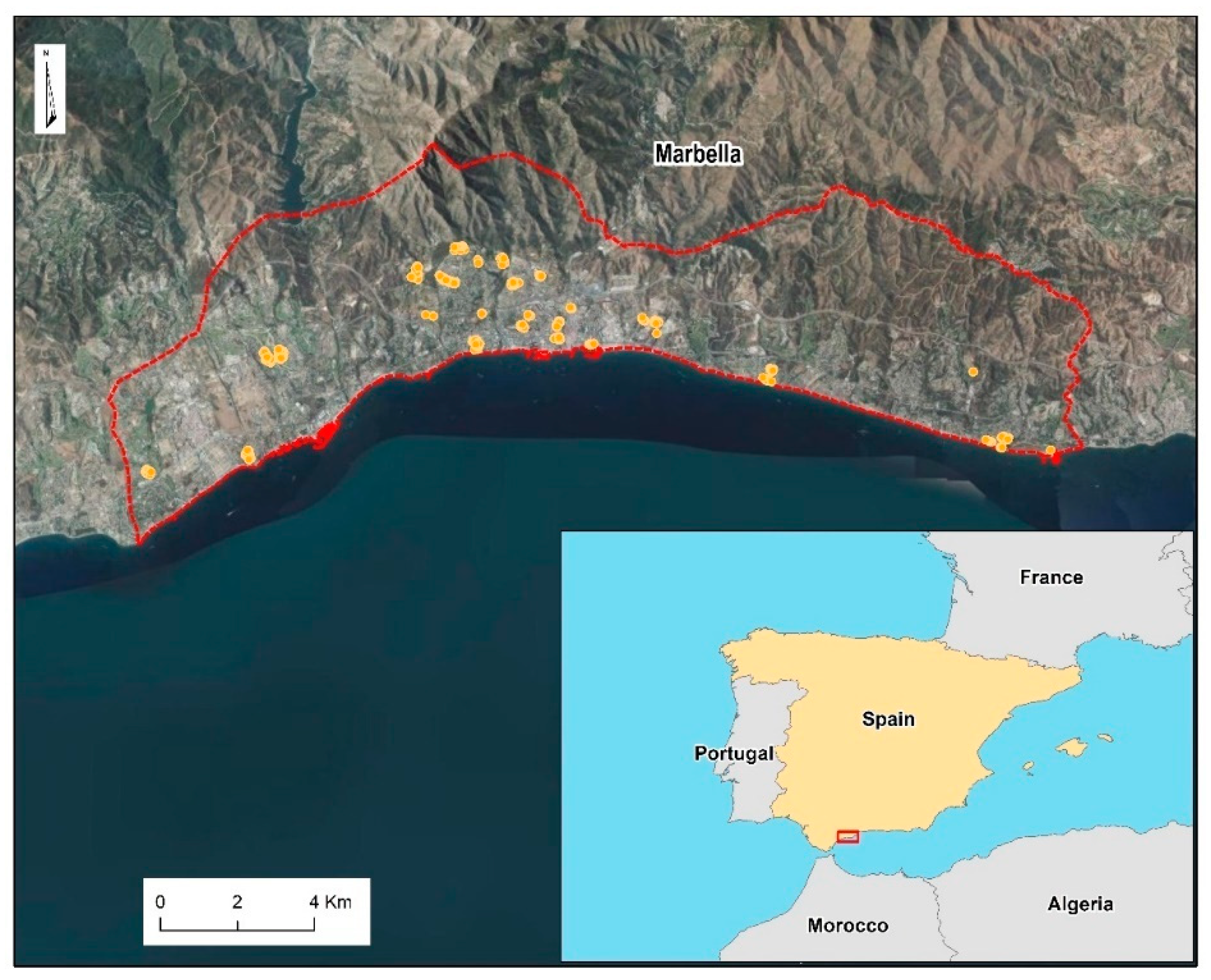
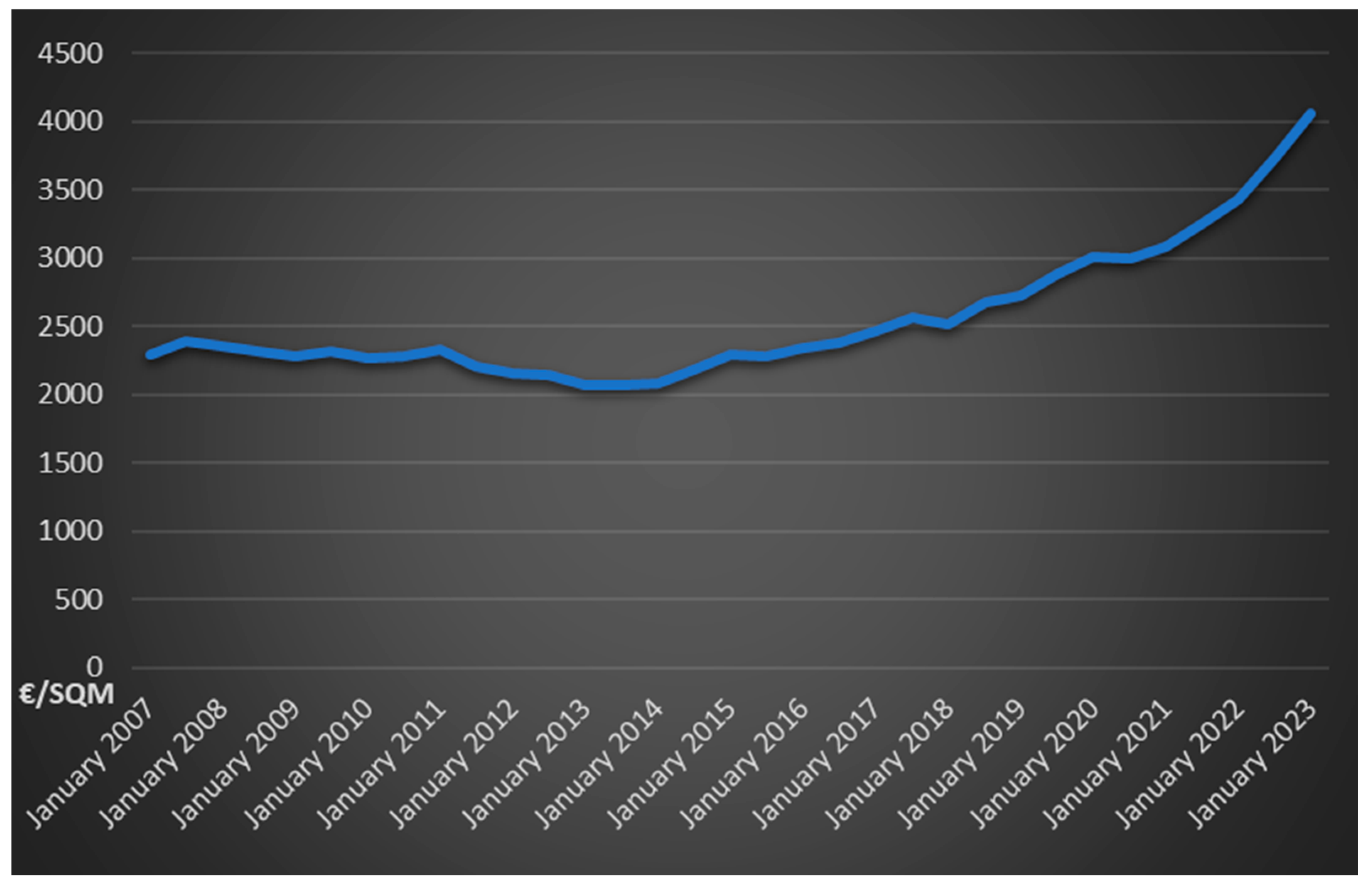
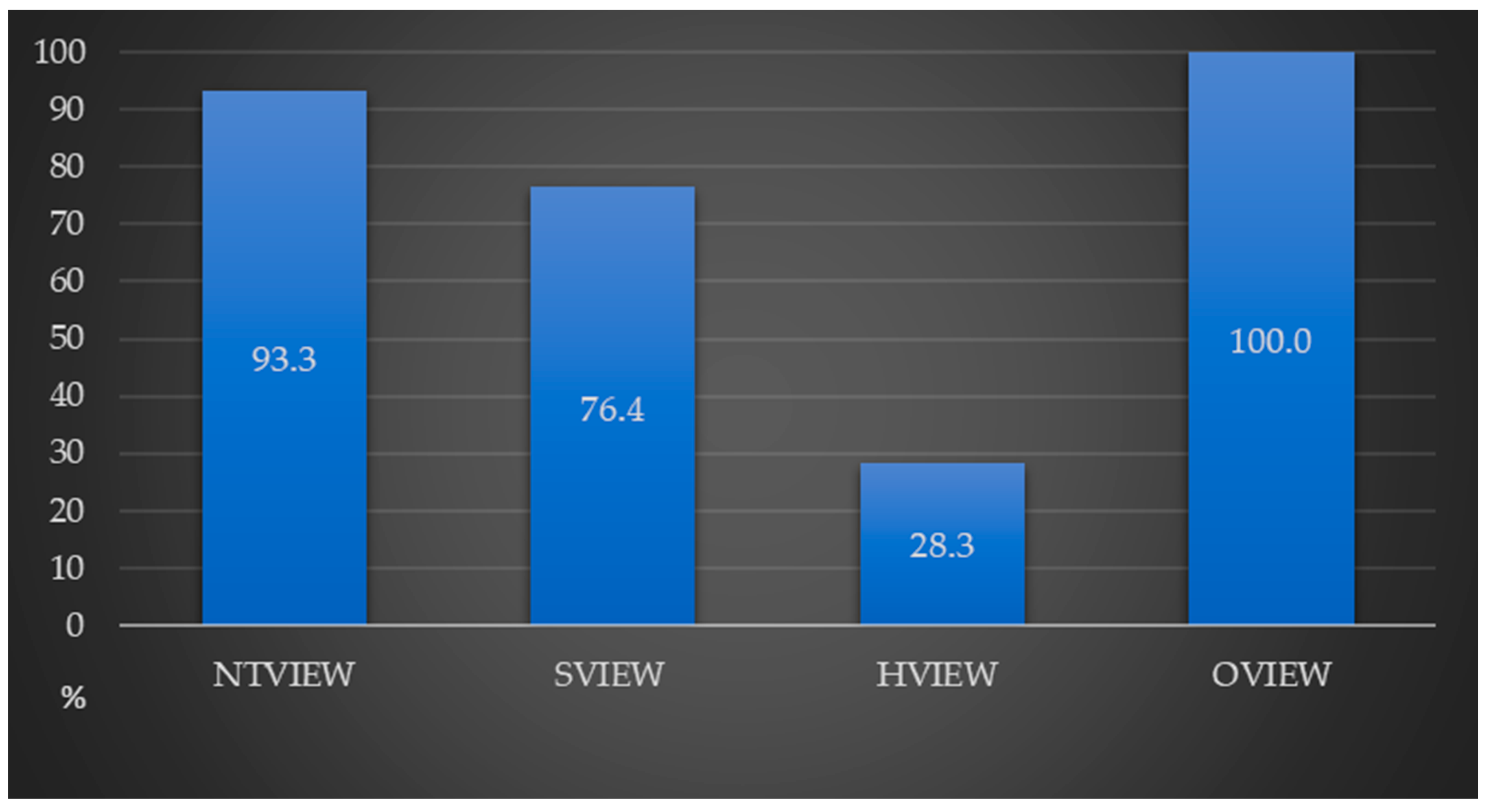
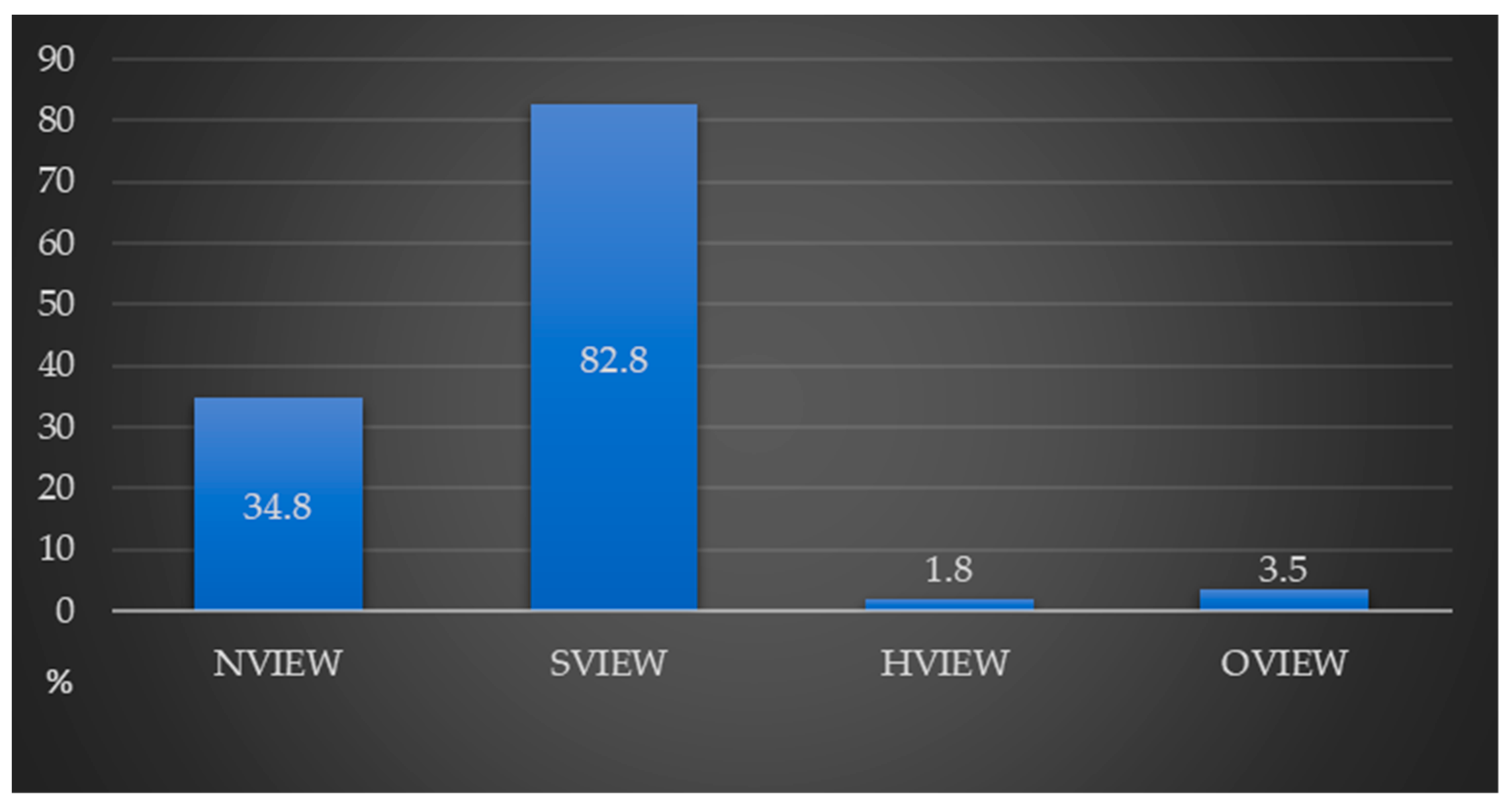
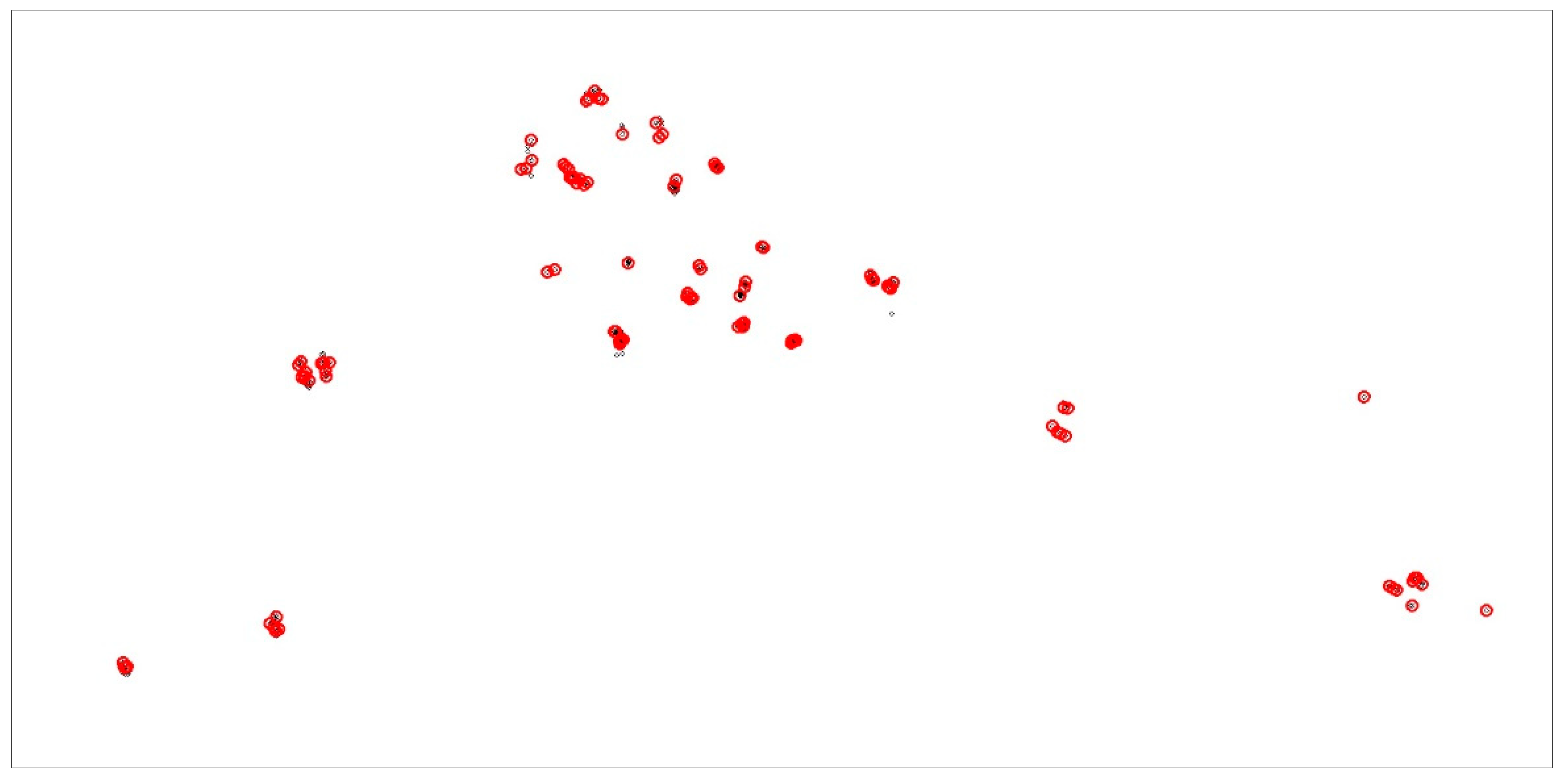
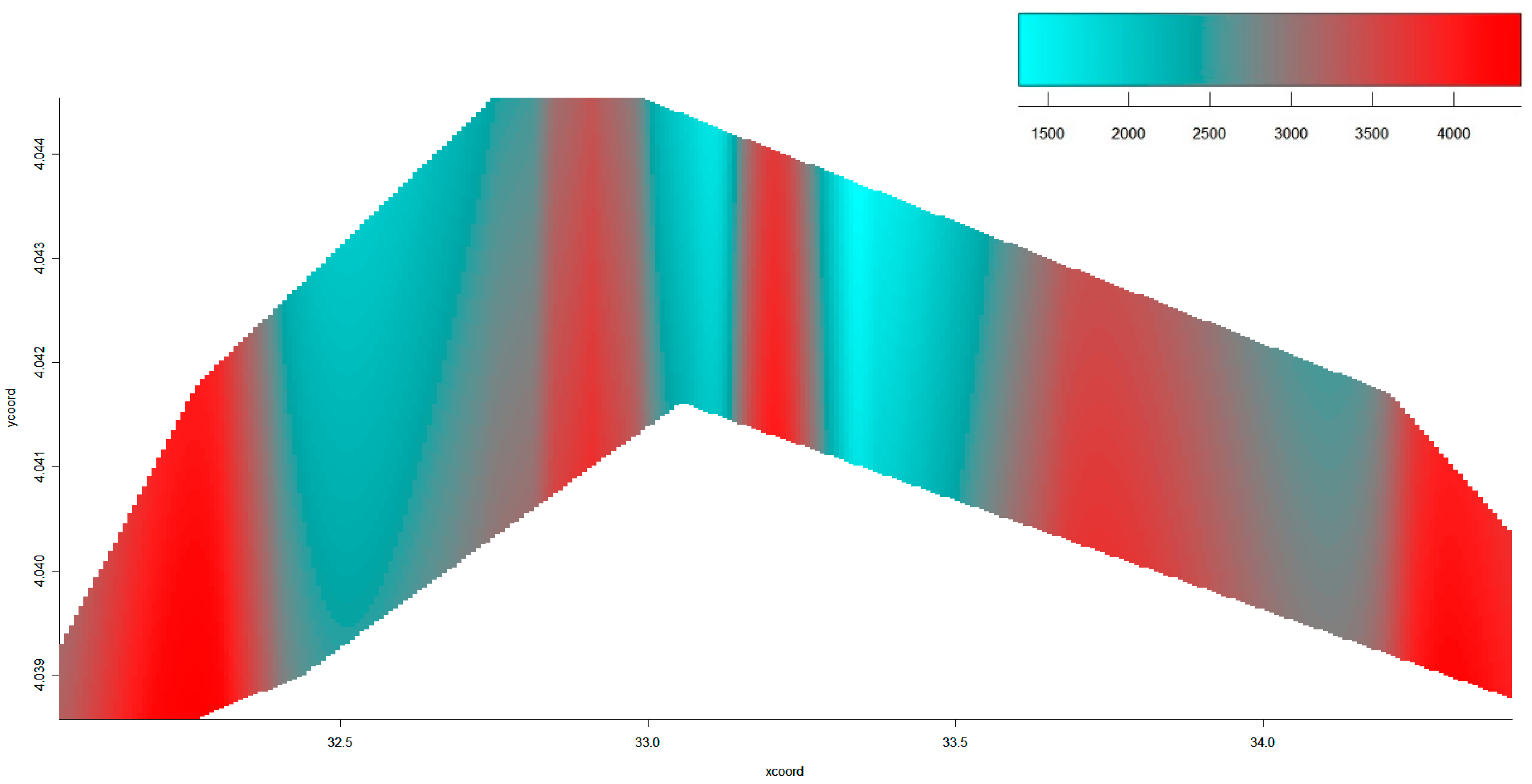
| Variable | Description |
|---|---|
| Housing sales price (PRICE) | Expressed in euros |
| Commercial area, the sum of the internal area and other virtualized secondary surfaces (AREA) | Expressed in square meters |
| Housing unit sales price (UPRICE) | Expressed in euros per square meter (UPRICE = PRICE/AREA) |
| Landscape views (VIEW) | Expressed in square meters for each view (natural environment, sea, old town, other) |
| Qualitative segment of the real estate market (TYPE) | Three levels: lower-middle, upper-middle, luxury |
| Euclidian distance to the sea (DIST) | Expressed in meters |
| Index | UPRICE | XCOORD | YCOORD | DIST | NTVIEW | SVIEW | HVIEW | OVIEW |
|---|---|---|---|---|---|---|---|---|
| Mean | 3639.8183 | 32.954502 | 4.0420688 | 1137.067 | 3,008,938.2 | 35,686,576 | 1755.7692 | 608,186.41 |
| Std. error | 52.901956 | 0.0242687 | 7.549 × 10−5 | 43.180856 | 123,399.03 | 2,347,550.5 | 213.06258 | 60,654.215 |
| Median | 3676.7893 | 32.976917 | 4.042123 | 789 | 2,640,525 | 12,581,450 | 0 | 169 075 |
| Std. deviation | 1061.9994 | 0.4871915 | 0.0015155 | 866.84964 | 2,477,218.3 | 47,126,747 | 4277.2014 | 1,217,624.9 |
| Kurtosis | 0.75846 | 1.0935251 | 0.082315 | −1.4045671 | 0.1256148 | 0.617069 | 5.7486999 | 16.900864 |
| Asymmetry | −0.3699597 | 0.6049463 | −0.7866755 | 0.3475425 | 0.7122325 | 1.3360771 | 2.6072192 | 3.8223405 |
| Range | 6954.3428 | 2.352083 | 0.005938 | 2764 | 12,782,600 | 165,089,800 | 22,650 | 8,091,100 |
| Minimum | 178.41158 | 32.047947 | 4.038591 | 36 | 0 | 0 | 0 | 175 |
| Maximum | 7132.7544 | 34.40003 | 4.044529 | 2800 | 12,782,600 | 165,089,800 | 22,650 | 8,091,275 |
| Confidence interval (95.0%) | 103.99904 | 0.0477095 | 0.0001484 | 84.888496 | 242,588.02 | 4,615,008.8 | 418.85603 | 119,239.07 |
| Variable | Coefficient | SE | Ratio | p-Value |
|---|---|---|---|---|
| Intercept | 5.375 × 105 | 5.402 × 106 | 0.09951 | 0.9207 |
| NTVIEW | −7.583 × 10−5 | 2.270 × 10−5 | −3.34100 | 0.0009 |
| SVIEW | 2.470 × 10−6 | 1.846 × 10−6 | 1.33800 | 0.1811 |
| HVIEW | −1.136 × 10−2 | 1.617 × 10−2 | −0.70240 | 0.4826 |
| OVIEW | 8.084 × 10−5 | 8.555 × 10−5 | 0.94500 | 0.3448 |
| Variable | df | spar | Knots | |
| f (XCOORD, YCOORD) | 12.68 | 264.8000 | 34 | |
| f (DIST) | 18.12 | 0.1086 | 100 |
| Other Views | Sea Views | Natural Land Views | Old Town Views | |
|---|---|---|---|---|
| Other views | 1.00 | 32.73 | −1.07 | −0.01 |
| Sea views | 0.03 | 1.00 | −0.03 | 0.00 |
| Natural land views | −0.94 | −30.70 | 1.00 | 0.01 |
| Old town views | −140.52 | −4599.19 | 149.81 | 1.00 |
Disclaimer/Publisher’s Note: The statements, opinions and data contained in all publications are solely those of the individual author(s) and contributor(s) and not of MDPI and/or the editor(s). MDPI and/or the editor(s) disclaim responsibility for any injury to people or property resulting from any ideas, methods, instructions or products referred to in the content. |
© 2023 by the authors. Licensee MDPI, Basel, Switzerland. This article is an open access article distributed under the terms and conditions of the Creative Commons Attribution (CC BY) license (https://creativecommons.org/licenses/by/4.0/).
Share and Cite
Castro Noblejas, H.; De Paola, P.; Vías Martínez, J. Landscape Value in the Spanish Costa del Sol’s Real Estate Market: The Case of Marbella. Land 2023, 12, 987. https://doi.org/10.3390/land12050987
Castro Noblejas H, De Paola P, Vías Martínez J. Landscape Value in the Spanish Costa del Sol’s Real Estate Market: The Case of Marbella. Land. 2023; 12(5):987. https://doi.org/10.3390/land12050987
Chicago/Turabian StyleCastro Noblejas, Hugo, Pierfrancesco De Paola, and Jesús Vías Martínez. 2023. "Landscape Value in the Spanish Costa del Sol’s Real Estate Market: The Case of Marbella" Land 12, no. 5: 987. https://doi.org/10.3390/land12050987
APA StyleCastro Noblejas, H., De Paola, P., & Vías Martínez, J. (2023). Landscape Value in the Spanish Costa del Sol’s Real Estate Market: The Case of Marbella. Land, 12(5), 987. https://doi.org/10.3390/land12050987









